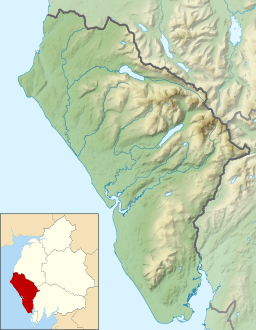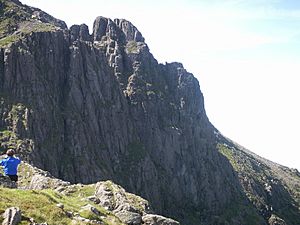Pillar (Lake District) facts for kids
Quick facts for kids Pillar |
|
|---|---|

Pillar from the east. Pillar Rock is clearly visible on the skyline on the right.
|
|
| Highest point | |
| Elevation | 892 m (2,927 ft) |
| Prominence | 348 m (1,142 ft) |
| Parent peak | Great Gable |
| Listing | Marilyn, Hewitt, Wainwright, Nuttall |
| Geography | |
| Location | Cumbria, England |
| Parent range | Lake District, Western Fells |
| OS grid | NY171121 |
| Topo map | OS Landranger 89, Explorer OL4 |
| Listed summits of Pillar (Lake District) | ||||
| Name | Grid ref | Height | Status | |
|---|---|---|---|---|
| Pillar Rock | NY171123 | 780 m (2,558 ft) | Nuttall | |
| Looking Stead | NY186117 | 627 m (2,057 ft) | Nuttall | |
Pillar is a big mountain in the western part of the Lake District in England. It stands between two valleys: Ennerdale to the north and Wasdale to the south. Pillar is the tallest mountain in its local group of fells.
At 892 metres (2,927 feet) high, it's the eighth-highest mountain in the Lake District. The mountain gets its name from Pillar Rock, a famous rock formation on its Ennerdale side. This rock is known as the place where rock climbing first started in the Lake District!
Contents
Where is Pillar Located?
Pillar is part of the Western Fells in the Lake District. These fells form a huge horseshoe shape around the long, wild Ennerdale valley. Pillar is on the southern side of this horseshoe.
The mountain has impressive crags (steep rock faces) that stretch along its northern side, facing Ennerdale. These crags are made up of two main levels. Below the upper crags, there's a path called the 'High Level Route'. Even lower down, you can find Pillar Rock and other crags like Raven and Ash Crags. The lower parts of the mountain are covered with a wide area of conifer trees.
On its southern side, Pillar looks down into Mosedale, one of the main valleys leading into Wasdale. While the Ennerdale side has dramatic cliffs, the Mosedale side has some rocky areas too, like Wistow Crags.
The very top of Pillar is at its western end. From there, the mountain ridge goes east for about a mile, slowly getting lower. This ridge leads to another smaller peak called Looking Stead. Beyond Looking Stead is Black Sail Pass, which is a path used by walkers to get between Wasdale and the top of Ennerdale.
What is Pillar Made Of?
The main rocks found at the top of Pillar are a type of lava called andesite. You can also find layers of sandstone and other volcanic rocks. These rocks tell the story of ancient volcanoes that shaped the Lake District millions of years ago.
The area around Pillar, including the Ennerdale Fells, is a Site of Special Scientific Interest. This means it's a special place for nature and wildlife.
The Top of Pillar Mountain
The very top of Pillar is surprisingly wide and covered in grass, with patches of stones. You'll find an Ordnance Survey triangulation column there, which is a marker used for mapping. There's also a stone cairn (a pile of stones) and a shelter to protect you from the wind.
From the summit, the views are amazing! You can see almost all the major fells in the Lake District, except for the Coniston range. You can also spot Loweswater and Ennerdale Water (two lakes), along with Burnmoor Tarn. If you go to the northern edge of the summit, there's another wind shelter. From there, you get a fantastic view of the famous Pillar Rock below.
How to Climb Pillar
Most people start their climb of Pillar from Wasdale Head, which is the closest place with road access.
- The Easiest Way: A simple way to climb Pillar is to take the Black Sail Pass. This path goes up to about 545 metres (1,788 feet). From there, you can walk up the mountain's gentler eastern ridge to the summit.
- The High Level Route: For a more exciting climb, you can leave the eastern ridge (at about 640 metres or 2,100 feet) and join the "High Level Route." This is a narrow path that goes around the northern cliffs of Pillar. It offers great views of Pillar Rock as you get closer to the summit from the north.
- The Mosedale Horseshoe: Many experienced walkers in Wasdale climb Pillar as part of a longer circular walk called the Mosedale Horseshoe. This route goes around the skyline of one of Wasdale's side valleys and includes other peaks like Scoat Fell, Red Pike, and Yewbarrow. Sometimes, Kirk Fell is also added to this challenging walk.
You can also climb Pillar from Ennerdale. From the YHA youth hostel at Black Sail, it's a short walk to the top of Black Sail Pass. From there, you can follow the same routes mentioned above. However, the Black Sail hostel is quite far from any public road, so this approach is better for those staying at the hostel rather than day-trippers. There are also other paths from lower down the Ennerdale valley that let you get closer to the impressive northern cliffs.
For strong walkers, there are other ways to reach Pillar that are easier to get to from popular tourist spots like Keswick.
- From Buttermere: You can climb and then descend the Scarth Gap Pass between Gatesgarth and Black Sail. This then allows you to go up via Black Sail Pass, as described earlier. This walk from Gatesgarth to Pillar's summit and back involves climbing over 1,200 metres (4,000 feet)!
- From Honister Pass: Another option is a ten-mile round trip from the Honister Pass. You can follow the Moses Trod footpath around the head of Ennerdale to Beck Head col (a dip between two mountains) between Great Gable and Kirk Fell. Then, take the path under Kirk Fell to the top of Black Sail Pass, and continue to Pillar.
Pillar Rock: A Climbing Legend
Pillar Rock is a large, famous rock that stands out on the northern side of Pillar mountain. It's surrounded by steep cliffs and is quite a bit lower than the main summit. When you see it from Ennerdale, it looks like a tall, thin column, which is how it got its name. In the early 1800s, it became well-known as one of the amazing sights of the Lake District. The famous poet William Wordsworth even wrote about it in his poem The Brothers:
You see yon precipice—it almost looks
Like some vast building made of many crags,
And in the midst is one particular rock
That rises like a column from the vale,
Whence by our Shepherds it is call'd, the Pillar.
– Wordsworth, The Brothers
The first recorded time someone climbed Pillar Rock was in 1826 by John Atkinson. His route, called the Old West Route, is still considered a rock climb today, though it's rated as "Moderate" (one of the easier grades). This was the very first recorded rock climb in the Lake District! Over the years, many climbers have explored Pillar Rock, and by 1872, four different climbing routes had been discovered.
Today, the easiest way to get to the top of Pillar Rock is the Slab and Notch route, which is a grade 3 scramble (meaning you need to use your hands a lot, but it's not full-on climbing). A more classic climbing route is the New West, which is a "Difficult" rock climb. By 2007, over 90 different climbs had been recorded on Pillar Rock!
In 1913, George Mallory, who later became famous for trying to climb Mount Everest, climbed Pillar Rock with Alan Goodfellow. Their route, now known as "Mallory's Route," is graded as "Hard Very Severe 5a." This is similar in difficulty to a challenging part of Mount Everest called The Second Step.
Pillar Rock is special because it's the only summit on the "Nuttalls" list (a list of mountains in England and Wales) that you can't reach without doing some actual rock climbing.




